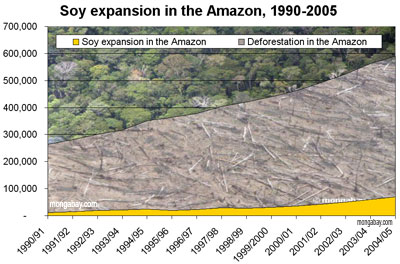Corn planting to drop 8% in 2008
Corn planting to drop 8% in 2008
mongabay.com
March 31, 2008
|
|
The UDSA’s National Agricultural Statistics Service (NASS) expects American farmers to plant 86 million acres of corn in 2008, down 8 percent from last year. The news comes amid record high prices for competitive crops, including soybeans and wheat.
The “Prospective Plantings” report shows that soybean acreage will increase 18 percent from 2007 to 74.8 million acres, while wheat planting is expected to be up 6 percent to 63.8 million acres.
The shift towards soy production in the U.S. has not been enough to cool surging soy prices, which have caused Brazil to expand production in the Amazon region, triggering a jump in deforestation since last summer. Soy demand is rising for soy-based feed, industrial production and biodiesel.
 Total deforestation and area of soybean cultivation across states in the Brazilian Amazon. Overall soybean cultivation makes up only a small portion of deforestation, though its role is accelerating. Further, soybean expansion and the associated infrastructure development and farmer displacement is driving deforestation by other actors. Note: some soybean farms are established on already degraded rainforest lands and neighboring cerrado ecosystems. Therefore it would be inappropriate to assume the area of soybean planting represents its actual role in deforestation. |
Scientists say soy farming in the Amazon impacts Earth largest rainforest by fueling road construction and port expansion; driving direct forest clearing; and competing with traditional forms of land-use including cattle ranching in the region. Higher land prices push speculators and ranchers deeper into forest areas.
Meanwhile, American corn ethanol subsidies have been linked to a host of problems, including surging food prices, water shortages, pollution in the Gulf of Mexico, and deforestation abroad.